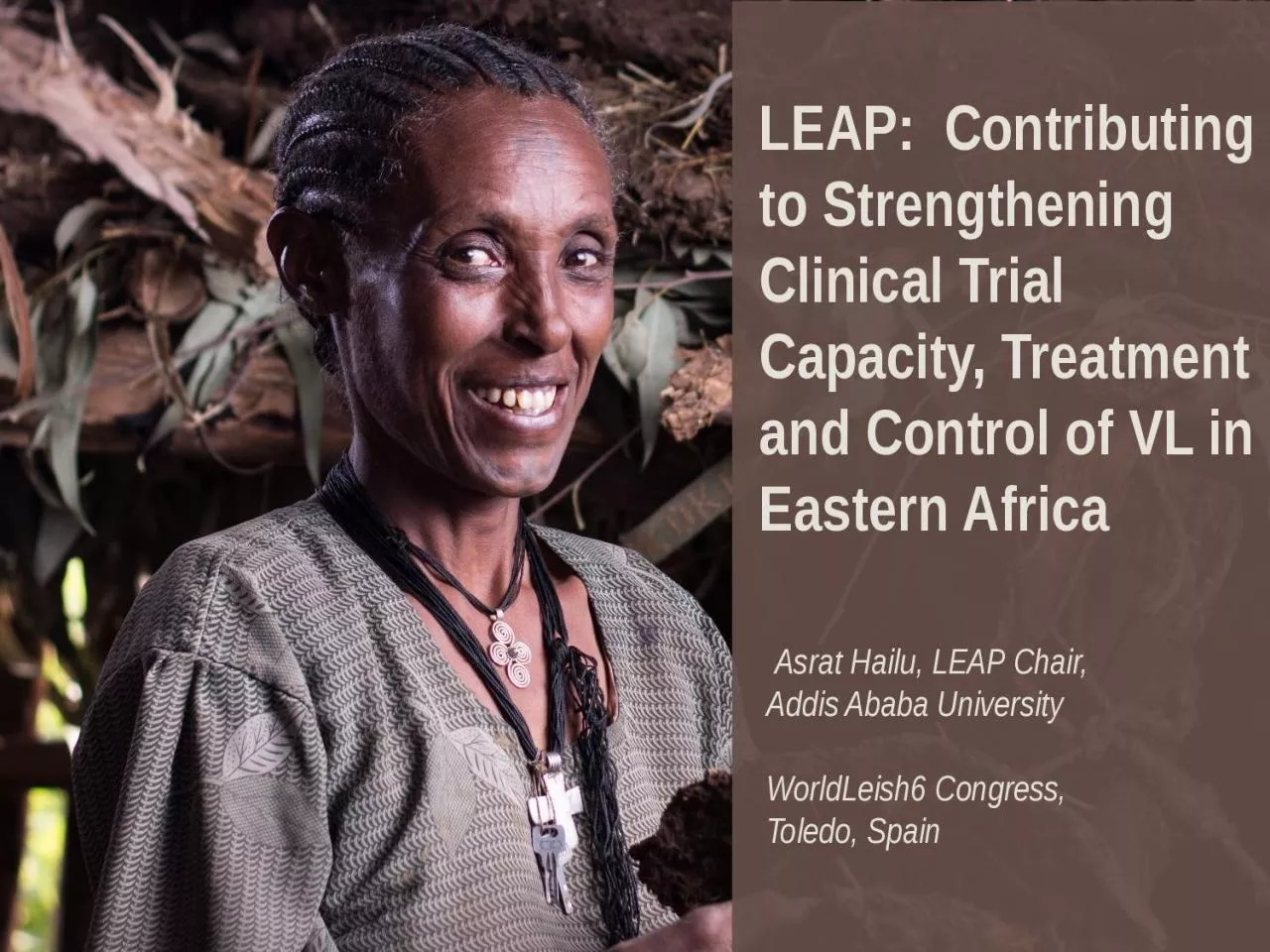

Addis Ababa University WorldLeish6 Congress Toledo Spain LEAP Contributing to Strengthening Clinical Trial Capacity Treatment and Control of VL in Eastern Africa ID: 935175
Download Presentation The PPT/PDF document "Asrat Hailu, LEAP Chair," is the property of its rightful owner. Permission is granted to download and print the materials on this web site for personal, non-commercial use only, and to display it on your personal computer provided you do not modify the materials and that you retain all copyright notices contained in the materials. By downloading content from our website, you accept the terms of this agreement.
Slide1
Asrat Hailu, LEAP Chair,
Addis
Ababa UniversityWorldLeish6 Congress, Toledo, Spain
LEAP:
Contributing
to
Strengthening
Clinical
Trial
Capacity
,
Treatment
and Control of VL in
Eastern
Africa
Slide2SUDAN:
Univ. of Khartoum
Federal Ministry of HealthETHIOPIA: Addis Ababa Univ.Gondar Univ.Ministry of HealthKENYA:KEMRIMinistry of HealthUGANDA:Makerere Univ.Ministry of HealthLeishmaniasis East Africa Platform (LEAP)
LEAP
- is a
clinical research network that brings together experts from leishmaniasis endemic eastern African countries to facilitate clinical testing and improved access to better treatments for leishmaniasis in the region.
Study sites:
Gondar (Eth)
Arbaminch
(Eth)
Abdurafi
(Eth)
Kassab
(Sudan)
Dooka
(Sudan)
Um el
kher
(Sudan)
Amudat
(Uganda)
Kimalel
(Kenya)
Kacheliba
(Kenya)
Slide3Leishmaniasis East Africa Platform (LEAP)
Membership - approx. 60 individual members, representing over 20 institutionsFounded in 2003 in Khartoum, Sudan Membership is drawn from the four African countries most affected by visceral leishmaniasis (Ethiopia, Kenya, Sudan, Uganda) as well as international experts.
Founded in 2003 with support from DNDiLEAP Objective: “…conduct clinical testing and facilitate improved access to better treatments for leishmaniasis in the region”
Slide4LEAP Activities - Capacity Building
Training
Infrastructure
Lab Upgrading
Research
Combination treatment delivered
More in the pipeline
High standard of research in endemic areas
Clinical research in difficult field conditions
Slide5Working with community leaders & governments
Media coverage and advocacy
LEAP meetings
LEAP Activities –
Access/Advocacy
Supporting treatment
Slide6No. VL cases (Jan.2014 – May 2016)
Site
Average VL cases per monthGondar39Kacheliba25Doka15Arba Minch, Amudat10Kimalel9The Numbers10 Clinical Trials13 Scientific Publications7,578 patients VL patients treated within and outside clinical studies (2010-2015)Over 800 staff received Short-term trainings Over 20 Long-term
trainings
Slide7Year
Study
EnrolledPhaseCOMPLETED STUDIES2004-2010SSG&PM1149Phase III2009-2011AmBisome® single dose124Phase II2010-2012AmBisome® /SSG/ miltefosine151Phase II2011-2013PV study3126Phase IV2013-2014fexinidazole14Phase II2015-2016Urine study55Diagnostic2014-2016VL/HIV study60Phase II2015-2016miltefosine PK30Phase II
UPCOMING STUDIES
2017
miltefosine
PM
To enroll
546
Phase III
Clinical studies since inception
Slide8One treatment delivered, recommended, implemented
Easy to use
AffordableField-adaptedNon-patented17 day combination treatmentRecommended as first line treatment in East Africa by WHO in 2010National VL treatment Guidelines revisedSupporting treatment access strategies for SSG&PM
Slide9Advantages of LEAP Collaboration
Combined burden of neglected disease-
can do more together with less resources. Development of regional clinical trial capacity hat will contribute to sustainable capacity strengtheningNo duplication of effort – research priorities avoiding duplicationRegistration - can leverage on regional registration initiativeDevelopment of joint proposals making sourcing of research funds easier Research owned by members, hence trusted by community and governments (e.g. regulatory authorities). Governments readily give support thus easier translation of research results into policy
Slide10Future perspectives: strengthening LEAP
New Rationale for LEAP, opportunity to address challenges:
New DNDi Business Plan 2015-2023; ARO Strategic Plan 2016-2023 (treatment, policy, NCEs..)Extended VL portfolio (VL, CL, PKDL, Phase 1-4 trials, access, advocacy…)Existing opportunities for expansion, inclusion of new partners in the platform Opportunities for innovative partnerships, new alliances (governments, industry, other stakeholders)
2003-2016
Made progress in fulfilling mandate (achievements-clinical trials, publications, capacity building & strengthening, policy change)
There have been challenges
Need to strengthen the platform
Revisit existing governance structure and membership
More visibility in countries
More priority on access, policy and advocacy for
leish
Slide11Acknowledgements
Study participants and the communitiesLEAP PartnersTrial Sites and the field team (Nurses and lab technicians, clinical monitors, DSMB)
MoH Kenya and Gederaf State, SudanDNDi Geneva and DNDi Africa Regional Office team
Slide12LEAP Partners
Slide13THANK YOU
TO ALL OUR
Donors to the LEAP Platform
by
Slide14Give
neglected patients a voice. They exist and must be heard.Thank
you
.